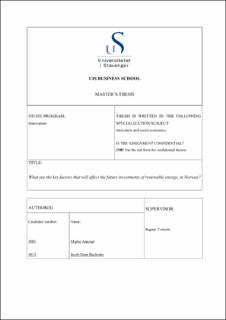| dc.contributor.advisor | Tveterås, Ragnar | |
| dc.contributor.author | Hackman, Jacob Dean | |
| dc.contributor.author | Aanstad, Martin | |
| dc.date.accessioned | 2020-09-21T14:13:09Z | |
| dc.date.available | 2020-09-21T14:13:09Z | |
| dc.date.issued | 2020-06-15 | |
| dc.identifier.uri | https://hdl.handle.net/11250/2678877 | |
| dc.description | Master's thesis in Economics | en_US |
| dc.description.abstract | This thesis aims to identify which key factors that will affect future investments within renewable energy in Norway. Due to a rapidly expanding market, the first sub-question is formulated to find how the global trends within renewable energy influence the Norwegian market. The second sub-question proposes to find whether externalities can delay the development of wind power. The research is decisive since newer renewable energy sources are currently not sustainable from a business perspective as it is reliant on governmental subsidies. A multi-method explorative approach based on qualitative and quantitative data collection is employed. Results from the analysis show that the removal of green certificates and the establishment of new taxes will affect future investments, since instalments becomes less profitable. Development of hydropower plants at less optimal areas will result in lower income for the producer, since the LCOE of hydropower is expected to be stagnant towards 2040. A decrease in new instalments of hydropower plants and continuous improvements to existing power plants is expected. The governments will continue the expansion of renewable energy production, so it is expected that there will still be subsidies. Furthermore, nuclear power is not expected to flourish in Norway in the next 20 years due to the development time, investments costs and historical events of nuclear meltdowns.
Moreover, offshore wind power and wave power in Norway is still underdeveloped and would require subsidies for implementation. To solve the identified challenges of onshore wind power development the government should reduce the duration of a concession or set requirements for finished instalment within ten years. In addition, there should be a requirement on the maximum size wind turbines can have in concession approved areas to reduce the visual impact. To reduce the environmental externalities developers can utilize a smaller area by building larger wind turbines that generate the same amount of energy. Visual effects can be reduced if the locations are properly managed by NVE and the municipalities by avoiding building in populated areas. Subsequently, it is important that the protesting citizens are heard by the government, which implies that the Consequence Evaluation Program may need adjustments. | en_US |
| dc.language.iso | eng | en_US |
| dc.publisher | University of Stavanger, Norway | en_US |
| dc.relation.ispartofseries | Masteroppgave/UIS-HH/2020; | |
| dc.rights | Navngivelse 4.0 Internasjonal | * |
| dc.rights.uri | http://creativecommons.org/licenses/by/4.0/deed.no | * |
| dc.subject | økonomi | en_US |
| dc.subject | administrasjon | en_US |
| dc.subject | social economics | en_US |
| dc.subject | renewable energy | en_US |
| dc.subject | fornybar energi | en_US |
| dc.subject | innovation | en_US |
| dc.subject | innovasjon | en_US |
| dc.title | What are the key factors that will affect the future investments of renewable energy, in Norway? | en_US |
| dc.type | Master thesis | en_US |
| dc.subject.nsi | VDP::Social science: 200::Economics: 210::Business: 213 | en_US |

